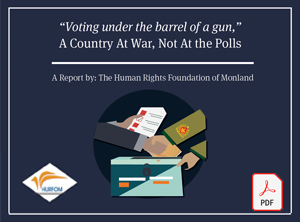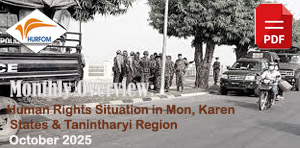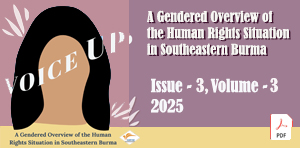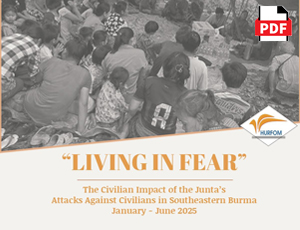High fees and low incomes drive rising student dropout rates
October 24, 2012
HURFOM: Over the past few years, the dropout rate for middle and high school students in Mon areas has increased as a result of mounting education costs and job shortages among the parent population. Students report that school fees have more than doubled, while test scores show that scholastic achievement has not improved. Interviews collected earlier this month from teachers and 11 Mon students illustrate the challenges faced by young people who report they simply cannot afford school after 8th or 9th grade.
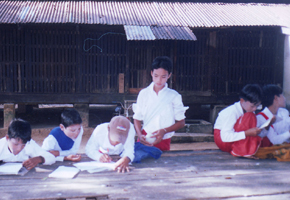 One former teacher explained, “Due to the increase in costs, more students are dropping out of school. Before tutoring in Thanbyuzayat Township began in the 2008-2009 academic year, around six or seven students passed the [annual] matriculation exam and it cost about 300,000 kyat to cover school fees each year. Since 2009, six or seven students still pass the matriculation exam, but they pay around 700,000 kyat per year. In 2010, only one student passed the final tutoring exam in Thanbyuzayat Township. The number of students passing their exams is the same, but the cost has more than doubled. This is one of the reasons that students quit school and that poor students who are eager to study are scared away. Without the tutorials, student could still pass the exam, it really just depends on how hard they work on their lessons.”
One former teacher explained, “Due to the increase in costs, more students are dropping out of school. Before tutoring in Thanbyuzayat Township began in the 2008-2009 academic year, around six or seven students passed the [annual] matriculation exam and it cost about 300,000 kyat to cover school fees each year. Since 2009, six or seven students still pass the matriculation exam, but they pay around 700,000 kyat per year. In 2010, only one student passed the final tutoring exam in Thanbyuzayat Township. The number of students passing their exams is the same, but the cost has more than doubled. This is one of the reasons that students quit school and that poor students who are eager to study are scared away. Without the tutorials, student could still pass the exam, it really just depends on how hard they work on their lessons.”
Since the 1970s, the number of Mon schools has gradually increased in the areas administered by the New Mon State Party (NMSP), the predominant ethnic Mon armed resistance group. Local villagers and the NMSP provide the funds needed to operate and maintain these schools, an example of which is Nyi Sar National High School located in southern Ye Township and established by the NMSP’s Mon National Education Committee in 1997. Nyi Sar serves students who cannot afford government schools or who live in remote villages and sites for internally displaced people (IDP) situated far from Burmese public schools. However, attending Nyi Sar requires some students to travel a great distance on foot to continue their education.
Min Saung Mon, 18, is a resident of Bleh Don Phite camp, a site for IDPs near the Thai-Burma border. He said, “After hearing how expensive the costs for living, food, and books would be this year, and considering the school in Nyi Sar is so far away, ten students in our village, including me, and in Halockhani [IDP camp] dropped out of school. This year and last year, many students stopped going to school. When I see other students who still go, I feel sad and would like to join school again.”
The roughly 300 schools in Mon areas are categorized as either Mon national language schools, joint Mon and Burmese schools, or schools that teach languages not formally recognized by the government.
Student Mi Hong Sar, 15, lives in Halockhani camp and recounted, “Three of my friends from Bleh Don Phite camp said that in one year, a grade 10 student who attends tutoring sessions in Thanbyuzayat Township has to spend about 15,000 kyat to support the school, 700,000 kyat in school fees, and around 400,000 kyat for expenses like clothes, food, and other supplies. For me, I stopped school and am helping my parents work.”
On top of increased school fees, there are limited employment opportunities in IDP and rural areas like Halockhani village. Many parents struggle to find reliable sources of income, and often travel to Thailand or Malaysia for migrant work. Young people also emigrate in search of jobs, opting to stop school at an early age to supplement the family finances. Students may be able to continue some form of their education abroad in programs like “Gawsanor,” a Thai language course that provides two to three hours of weekly instruction, but most focus on earning a salary that will support them and their families.
Halockhani resident Mi Doon Malay, 20, said, “After passing grade 9, I continued my education at the school in Nyi Sar. I faced many difficulties covering the costs of school, food, travel, and clothes. Also, there are not many jobs in Halockhani, so my parents have a hard time finding work. My mother sells snacks and my father repairs broken umbrellas, and they were not able to support my studies. I dropped out of school in 2010 and went to Sangkhlaburi, Thailand, to work. Some of my friends who couldn’t continue school went to work in Bangkok.”
According to Mi Hong Sar Htew, 17, from Halockhani, “There are no jobs in my village so [my siblings and I] came to Thailand to work after I dropped out of school in grade 8. Now we work at a restaurant and earn 2,500 baht per month. This kind of job is not suitable for a long-term career, so we are still looking for another job that provides a good salary. If we get a job like that, we can send money to our parents.”
Comments
Got something to say?
You must be logged in to post a comment.



